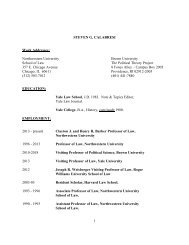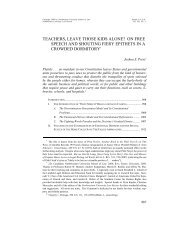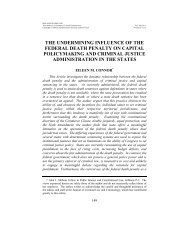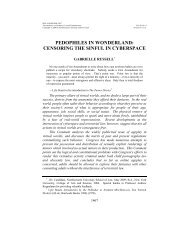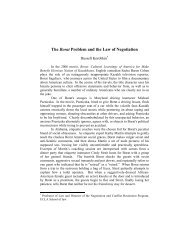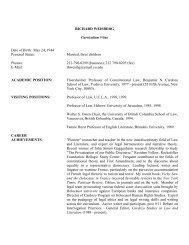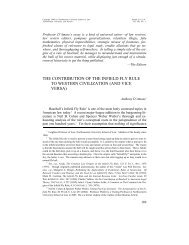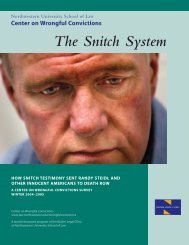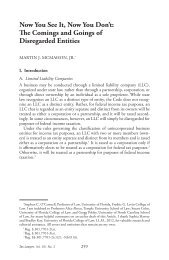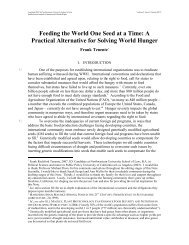The Reverse Triangular Merger Loophole and Enforcing Anti
The Reverse Triangular Merger Loophole and Enforcing Anti
The Reverse Triangular Merger Loophole and Enforcing Anti
You also want an ePaper? Increase the reach of your titles
YUMPU automatically turns print PDFs into web optimized ePapers that Google loves.
1040<br />
N O R T H W E S T E R N U N I V E R S I T Y L A W R E V I E W<br />
tractual complications may lead to irreconcilable differences that can frustrate<br />
or completely destroy an M&A deal. 14<br />
<strong>The</strong> reverse triangular merger structure has emerged as a popular<br />
M&A vehicle 15 best used to circumvent the aforementioned contractual liabilities.<br />
16 In a reverse triangular merger, an acquiring entity forms a subsidiary<br />
corporation, <strong>and</strong> the newly created subsidiary merges with the target<br />
corporation. 17 <strong>The</strong> target company survives the merger <strong>and</strong> continues to<br />
own its assets, but the acquiring entity holds all of the target company’s<br />
stock <strong>and</strong> serves as the target company’s sole shareholder. 18 Because the<br />
target company survives the merger <strong>and</strong> is still the same “original party” to<br />
its preexisting contracts, 19 the reverse triangular merger process “purport-<br />
14 Stephen E. Gillette & Daniel R. Mitz, How to Secure Licenses You Pay For, DEALMAKER’S J.,<br />
June 2005, at 1. “In acquisitions where agreements with anti-assignment clauses are key assets, this lack<br />
of clarity can be an unpleasant due diligence surprise for both the acquirer <strong>and</strong> the target.” David Shine,<br />
Applicability of <strong>Anti</strong>-Assignment Clauses in <strong>Reverse</strong> <strong>Triangular</strong> <strong>Merger</strong>s, 11 M&A LAW. 8, 8–9 (2007).<br />
15 See JOSEPH B. DARBY III, PRACTICAL GUIDE TO MERGERS, ACQUISITIONS AND BUSINESS SALES<br />
192 (2006); <strong>The</strong>odore F. di Stefano, <strong>Reverse</strong> <strong>Merger</strong>s: <strong>The</strong>y’re Back!, E-COMMERCE TIMES, Jan. 1,<br />
2007, http://www.ectnews.com/story/54999.html. <strong>Reverse</strong> triangular mergers are on the rise in the<br />
United States. Approximately 222 U.S. companies listed as public companies in 2007 did so through<br />
reverse triangular merger transactions rather than through the traditional IPO process. See Ralph Amato,<br />
<strong>Reverse</strong> Shell <strong>Merger</strong>s <strong>The</strong>n <strong>and</strong> Now: Breaking Records, Gaining Steam, E-COMMERCE TIMES, Feb.<br />
20, 2008, http://www.ecommercetimes.com/story/61871.html. <strong>Reverse</strong> triangular mergers were expected<br />
to increase in 2008, especially since the Securities <strong>and</strong> Exchange Commission announced that<br />
they accept reverse triangular mergers as a viable way for companies to go public. Id.<br />
16 <strong>The</strong> reverse triangular merger structure has “long been used for public company acquisitions . . .<br />
[<strong>and</strong>] has also become the preferred structure for private company acquisitions since, unlike a stock purchase,<br />
it does not require the participation of all individual stockholders. And in the private company<br />
context, the applicability of anti-assignment clauses is particularly relevant since an acquirer of a private<br />
company may have the ability to require that the closing be conditioned on the receipt of necessary<br />
third-party consents.” Shine, supra note 14, at 8; see also Art Beroff & Dwayne Moyers, Put It in <strong>Reverse</strong>—Benefits<br />
of <strong>Reverse</strong> <strong>Merger</strong>s, ENTREPRENEUR, June 1999, at 8; Avital Louria Hahn, <strong>Reverse</strong><br />
<strong>Merger</strong>s on the Rise, INV. DEALERS DIG., May 29, 2006 (explaining that the recent economic environment<br />
has forced many enterprises to look to reverse triangular mergers for methods of “going public”<br />
other than through an IPO). <strong>The</strong> reverse triangular merger process can be accomplished in as few as two<br />
weeks for as little as $50,000–$150,000. See Beroff & Moyers, supra, at 8. <strong>Reverse</strong> triangular mergers<br />
are quick to market because the structure (1) circumvents the need for contractual consent from third<br />
parties; (2) fulfills public company requirements from state <strong>and</strong> federal regulators; <strong>and</strong> (3) does not engage<br />
an underwriter or investors on a roadshow to go public. See generally JAMES C. FREUND,<br />
ANATOMY OF A MERGER 79 (1975); <strong>The</strong> Rise of “<strong>Reverse</strong> <strong>Merger</strong>s,” M&A ADVISOR, Sept. 2003, at 1–<br />
2, available at http://www.nixonpeabody.com/linked_media/publications/MAAdvisor_09002003.pdf.<br />
17 See Elaine D. Ziff, <strong>The</strong> Effect of Corporate Acquisitions on the Target Company’s License<br />
Rights, 57 BUS. LAW. 767, 787–89 (2002); see also supra note 9 <strong>and</strong> accompanying text.<br />
18 See Michael Amm, Canada’s Booming M&A Market: Trends <strong>and</strong> Strategic Considerations for<br />
Cross-Border Transactions, METROPOLITAN CORP. COUNS., Dec. 2006, at 11; Securities Law Institute,<br />
<strong>Merger</strong>s & Acquisitions, http://www.securitieslawinstitute.com/m&a.html#reverse%20triangular%20<br />
merger (last visited Apr. 14, 2009).<br />
19 Ziff, supra note 17, at 787. For most practical purposes, the reverse triangular merger is similar<br />
to the sale of the target company’s stock. In a stock acquisition, the “corporate structure of the seller [or<br />
target company] continues intact <strong>and</strong> the conduct of the [target company’s] business is not affected by<br />
the transfer of stock ownership.” See CHARLES A. SCHARF ET AL., ACQUISITIONS, MERGERS, SALES,






